This item originally presented as a poster at the 7th Annual Cochlear Implant Conference - Manchester, UK, 4-6 September 2002.
Author details
Ilona Anderson
ilona.anderson@medel.com
+43-512-288889-543
Introduction
Children are being implanted at a younger age due to early hearing identification programs. We were interested in the suitability of the MED-EL TEMPO+ behind-the-ear speech processor for these young and very young children.
Methods and materials
Procedure:
Questionnaires were sent to 300 TEMPO+ users in Germany and the USA. 185 responses were received, 65 from parents of pediatric TEMPO+ users. These responses were analized for the study.
Questionnaire:
A custom made questionnaire of 50 questions was designed. Themes included: biographical information, TEMPO+ switches and controls, handling of the TEMPO+, general questions on the TEMPO+ and questions about TEMPO+ accessories. Most questions had multiple-choice options for answers, such as 'never', 'rarely', 'sometimes', 'often' and always. Some questions were open-ended. The questionnaire was available in German and English.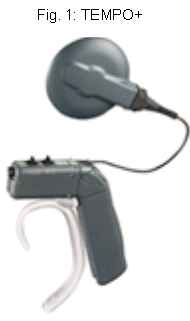
TEMPO+ speech processor:
All patients received the MED-EL TEMPO+ speech processor (fig. 1) and had to have a minimum of 4 weeks experience with the TEMPO+ speech processor. Hardware designs make use of the TEMPO+ suitable in children. The speech processor is modular in that there are a number of battery pack options available (pediatric, angled and straight). This allows parents to choose the most suitable method of fixing the TEMPO+ to their child's ear. The pediatric pack maybe clipped onto the collar for very young children. There are a number of moldable earhooks available to suit different size ears.
Results
From the total of 65 responses, 25 were male and 40 female. The age range was 1 year to 16 years, with a mean of 6 years 3 months. 1/3rd of responses were from families with children under 4 years. Children had been using the CI for 2 years 4 months on average, and had worn the TEMPO+ for an average of 8 months. 89.7% had used the CIS PRO+ body-worn processor previously. 94.2% wore behind-the-ear hearing aid prior to receiving their CI. None wore body-aids. Average hearing aid use was 3 1⁄2 years.
Responses to using the switches and controls of the TEMPO+ were very positive. Fig 2 details how subjects felt about using the volume and program switches. The majority found these ''very'' or ''fairly'' easy to use. Note that families with younger subjects (0 to 2 and 2 to 4) found these ''very easy'' to adjust. 62.1% found the sensitivity control ''very'' or ''fairly'' easy to adjust. There were no differences between age groups.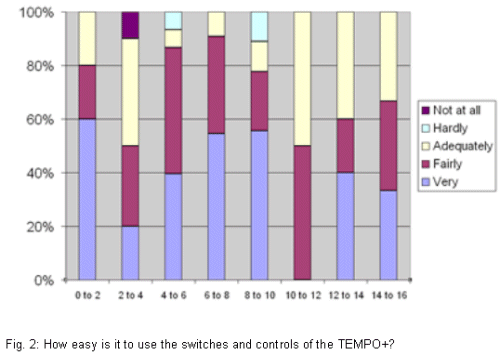
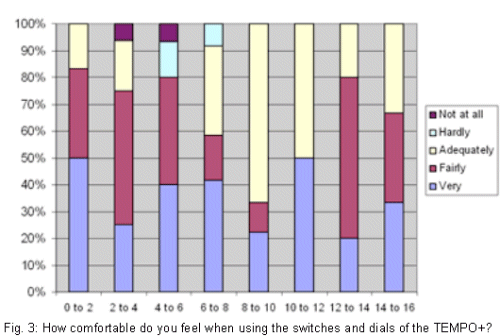
Figure 3 shows positive results to subjects' feeling comfortable with using the switches and dials of the TEMPO+. The TEMPO+ is modular in design to promote a wide variety of wearing options. 70% of parents reported having more than one battery pack. Of these, 49% rarely change the battery pack and 51% feel ''very comfortable'' when doing so. 41.2% of parents ''rarely'' change the their earhook, as most are provided with the pediatric earhook. Considering the weight and size of the TEMPO+, battery pack options and different earhooks, the majority of parents rated the TEMPO+ as ''very'' or ''fairly'' comfortable for their children to wear. (Fig 4)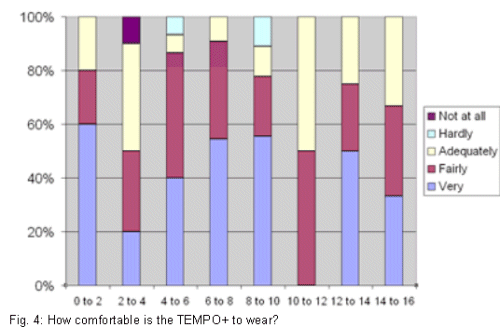
Finally, parents were asked about their overall satisfaction with the TEMPO+ (Fig 5). An overwhelming 48% reported being ''very satisfied'' with the TEMPO+ and 42.6% stating they were ''fairly satisfied''.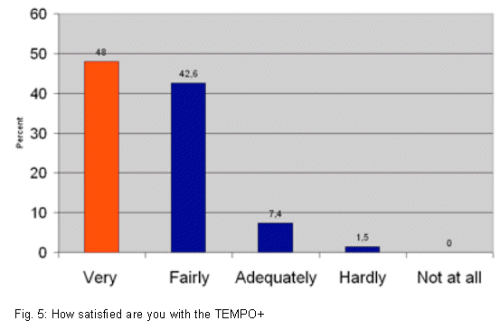
Conclusions
All results suggest that parents are satisfied with their child's TEMPO+. Positive feedback was recorded for handling, ease of manipulation and comfort. Results show the suitability of the TEMPO+ ear level speech processor for young and very young children.
For more information on MED-EL click here.
Click here to visit the MED-EL website.
The Use of the MED-EL TEMPO+ Ear-Level Speech Processor in Children
November 25, 2002
Share:
Related Courses
1
https://www.audiologyonline.com/audiology-ceus/course/singing-in-rain-using-music-22785
Singing in the Rain: Using Music to Reinforce Listening (Professionals)
Presented by Christine Barton, this course provides participants with additional approaches to using music for spoken language development in young deaf and hard of hearing children. A special emphasis on the use of songs that focus on listening and language development while a young child is playing in the water will be provided.
textual, visual
129
USD
Subscription
Unlimited COURSE Access for $129/year
OnlineOnly
AudiologyOnline
www.audiologyonline.com
Singing in the Rain: Using Music to Reinforce Listening (Professionals)
Presented by Christine Barton, this course provides participants with additional approaches to using music for spoken language development in young deaf and hard of hearing children. A special emphasis on the use of songs that focus on listening and language development while a young child is playing in the water will be provided.
22785
Online
PT60M
Singing in the Rain: Using Music to Reinforce Listening (Professionals)
Presented by Chris Barton, MM, MT-BC
Course: #22785Level: Intermediate1 Hour
No CEUs/Hours Offered
Presented by Christine Barton, this course provides participants with additional approaches to using music for spoken language development in young deaf and hard of hearing children. A special emphasis on the use of songs that focus on listening and language development while a young child is playing in the water will be provided.
2
https://www.audiologyonline.com/audiology-ceus/course/best-practices-for-cochlear-implant-33025
Best Practices for Cochlear Implant Candidacy: Pediatrics, in partnership with American Cochlear Implant Alliance
This course examines both the Food and Drug Administration and best-practice candidacy assessment practices for pediatric cochlear implantation. Medical, audiology, speech-language pathology, and other assessments and considerations will be discussed to help identify best practices for candidacy determination.
auditory, textual, visual
129
USD
Subscription
Unlimited COURSE Access for $129/year
OnlineOnly
AudiologyOnline
www.audiologyonline.com
Best Practices for Cochlear Implant Candidacy: Pediatrics, in partnership with American Cochlear Implant Alliance
This course examines both the Food and Drug Administration and best-practice candidacy assessment practices for pediatric cochlear implantation. Medical, audiology, speech-language pathology, and other assessments and considerations will be discussed to help identify best practices for candidacy determination.
33025
Online
PT60M
Best Practices for Cochlear Implant Candidacy: Pediatrics, in partnership with American Cochlear Implant Alliance
Presented by Denise Thomas, AuD, CCC-A, Lindsay Zombek, MS, CCC-SLP, LSLS Cert. AVEd
Course: #33025Level: Intermediate1 Hour
AAA/0.1 Intermediate; ACAud/1.0; AG Bell - LSLS/1.0 Domain 1; BAA/1.0; CAA/1.0; IACET/0.1; IHS/1.0; Kansas, LTS-S0035/1.0; NZAS/1.0; SAC/1.0
This course examines both the Food and Drug Administration and best-practice candidacy assessment practices for pediatric cochlear implantation. Medical, audiology, speech-language pathology, and other assessments and considerations will be discussed to help identify best practices for candidacy determination.
3
https://www.audiologyonline.com/audiology-ceus/course/implementation-cochlear-implants-enhanced-candidacy-37377
Implementation of Cochlear Implants: Enhanced Candidacy Criteria and Technology Advances
The participant in this course will understand the extended candidacy criteria with cochlear implantation and expectations. The course will cover implanting under age one, hybrid hearing with cochlear implantation, CI under local anesthesia, single-sided deafness, cochlear implantation, and auditory brainstem implantation.
auditory, textual, visual
129
USD
Subscription
Unlimited COURSE Access for $129/year
OnlineOnly
AudiologyOnline
www.audiologyonline.com
Implementation of Cochlear Implants: Enhanced Candidacy Criteria and Technology Advances
The participant in this course will understand the extended candidacy criteria with cochlear implantation and expectations. The course will cover implanting under age one, hybrid hearing with cochlear implantation, CI under local anesthesia, single-sided deafness, cochlear implantation, and auditory brainstem implantation.
37377
Online
PT60M
Implementation of Cochlear Implants: Enhanced Candidacy Criteria and Technology Advances
Presented by J. Thomas Roland, MD Jr.
Course: #37377Level: Intermediate1 Hour
AAA/0.1 Intermediate; ACAud/1.0; AHIP/1.0; ASHA/0.1 Intermediate, Professional; BAA/1.0; CAA/1.0; Calif SLPAB/1.0; IACET/0.1; IHS/1.0; Kansas, LTS-S0035/1.0; NZAS/1.0; SAC/1.0
The participant in this course will understand the extended candidacy criteria with cochlear implantation and expectations. The course will cover implanting under age one, hybrid hearing with cochlear implantation, CI under local anesthesia, single-sided deafness, cochlear implantation, and auditory brainstem implantation.
4
https://www.audiologyonline.com/audiology-ceus/course/using-gsi-for-cochlear-implant-39682
Using GSI for Cochlear Implant Evaluations
This course is designed to educate audiologists on the practical workflow for patients who require cochlear implants. From Food and Drug Administration (FDA) approved indications and Medicare requirements to pre-op and post-op evaluations, audiologists will gain a clear understanding of the cochlear implant process.
auditory, textual, visual
129
USD
Subscription
Unlimited COURSE Access for $129/year
OnlineOnly
AudiologyOnline
www.audiologyonline.com
Using GSI for Cochlear Implant Evaluations
This course is designed to educate audiologists on the practical workflow for patients who require cochlear implants. From Food and Drug Administration (FDA) approved indications and Medicare requirements to pre-op and post-op evaluations, audiologists will gain a clear understanding of the cochlear implant process.
39682
Online
PT60M
Using GSI for Cochlear Implant Evaluations
Presented by Joseph Dansie, AuD
Course: #39682Level: Introductory1 Hour
AAA/0.1 Introductory; ACAud/1.0; AHIP/1.0; BAA/1.0; CAA/1.0; Calif SLPAB/1.0; IACET/0.1; IHS/1.0; Kansas, LTS-S0035/1.0; NZAS/1.0; SAC/1.0
This course is designed to educate audiologists on the practical workflow for patients who require cochlear implants. From Food and Drug Administration (FDA) approved indications and Medicare requirements to pre-op and post-op evaluations, audiologists will gain a clear understanding of the cochlear implant process.
5
https://www.audiologyonline.com/audiology-ceus/course/adult-assessments-in-hearing-healthcare-38660
Adult Assessments in Hearing Healthcare: Working Across the Continuum
This five-course series on adult assessments in hearing health is intended to stimulate collaborative approaches for hearing health professionals, regardless of what hearing technologies they typically provide. Ideally, professionals will support patients in their long-term hearing loss journey, facilitating transitions when appropriate and a comfortable sense of the range of ways hearing loss can be addressed throughout one’s hearing journey.
auditory, textual, visual
129
USD
Subscription
Unlimited COURSE Access for $129/year
OnlineOnly
AudiologyOnline
www.audiologyonline.com
Adult Assessments in Hearing Healthcare: Working Across the Continuum
This five-course series on adult assessments in hearing health is intended to stimulate collaborative approaches for hearing health professionals, regardless of what hearing technologies they typically provide. Ideally, professionals will support patients in their long-term hearing loss journey, facilitating transitions when appropriate and a comfortable sense of the range of ways hearing loss can be addressed throughout one’s hearing journey.
38660
Online
PT300M
Adult Assessments in Hearing Healthcare: Working Across the Continuum
Presented by Camille Dunn, PhD, Susan Good, AuD, MBA, Alejandra Ullauri, AuD, MPH, Ted McRackan, MD, MSCR, Donna L. Sorkin, MA, Rene Gifford, PhD
Course: #38660Level: Intermediate5 Hours
AAA/0.5 Intermediate; ACAud/5.0; ASHA/0.5 Intermediate, Professional; BAA/5.0; CAA/5.0; Calif SLPAB/5.0; IACET/0.5; IHS/5.0; Kansas, LTS-S0035/5.0; NZAS/3.0; SAC/5.0; Tier 1 (ABA Certificants)/0.5
This five-course series on adult assessments in hearing health is intended to stimulate collaborative approaches for hearing health professionals, regardless of what hearing technologies they typically provide. Ideally, professionals will support patients in their long-term hearing loss journey, facilitating transitions when appropriate and a comfortable sense of the range of ways hearing loss can be addressed throughout one’s hearing journey.
